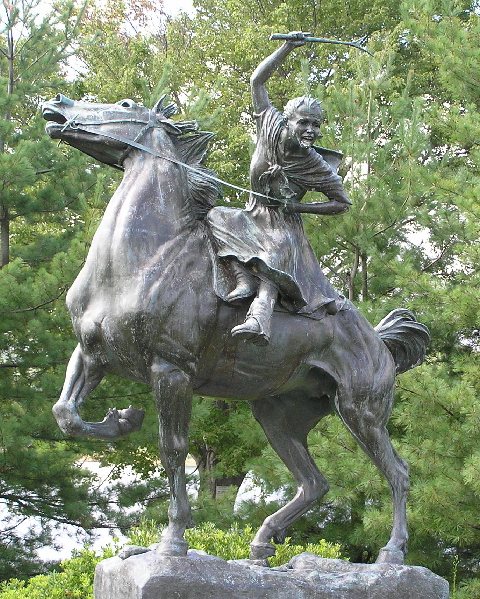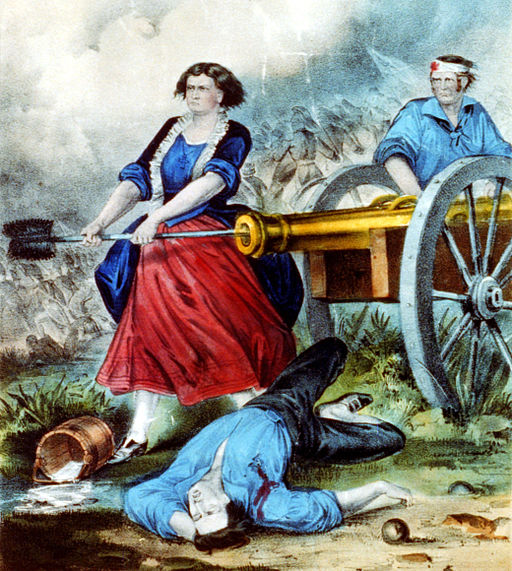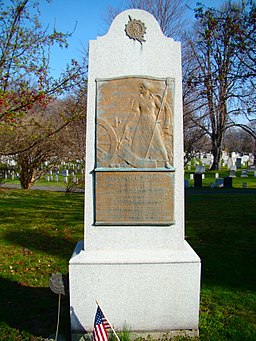
Happy International Women's Day!! It seems like the perfect time to do our second post for Women in Wars--our focus for Women's History Month this year. Today we will focus on the Revolutionary War. During the time of the Revolutionary War women were not even considered for military service. There were some roles that women were able to play for the military units. Wives, mothers and daughters of some soldiers would go with the military units and do the cooking, sewing and clothes washing for the men and they would get to sleep in a tent and get food. They were called camp followers by some and General George Washington called them women of the army. Women also helped with the care of injured soldiers. They served as nurses and were considered civilians. They received no military status or benefits and no medical training. They did jobs like feeding and bathing the patients as well as cleaning the beds and emptying the bed chambers. They were paid only about $2-$4 a month and often got ill from the soldiers.
Of course there were women who stayed home and kept the family farms and businesses going as well. There were some women who spied and shared information with the patriots. Others refused to purchase British goods. Others formed support groups that raised money and made uniforms for the soldiers. All of these women played important roles in the war but today I am going to focus on a few specific women who played important roles as well. I am using Heroism Begins with Her by Winifred Conkling and illustrated by Julia Kuo to gather some of the information as well as names to focus.
I also found Women Soldiers, Spies and Patriots of the American Revolution by Martha Kneib. Unfortunately I haven't been able to get my hands on it due to the library restrictions during the pandemic. There may be more women to explore in this book.Another great source to learn about the Revolutionary War and several of the women I am sharing here (as well as some of the ones who worked from home) is the Liberty Kids series. They were one of Hazel's favorites to watch when she was younger.
Sybil Ludington

Sybil Ludington was the eldest daughter of Henry and Abigail Ludington. She was the eldest of twelve children. She was born in 1761 in New York. Henry Ludington served in the military for over sixty years. In 1773 he changed from being a British loyalist to a patriot. On April 26, 1777, a rider arrived at the Ludington house to announce that Danbury, Connecticut was under attack by British troops and needed help. The rider was exhausted and Colonel Ludington needed to prepare for battle. Ludington's regiment was currently disbanded so the soldiers could plant their crops. Their houses were spread over miles and someone needed to step up and ride from farm to farm to gather the regiment. Sybil stepped up at 16-years-old and made the ride. Her ride was longer than the one Paul Revere rode. After the war Sybil met and married Edward Ogden. They had a son named Henry. Edward died of yellow fever in 1799. Four years later Sybil bought a tavern and helped her son become a lawyer. When she sold the tavern she received three times the purchase price. She used the money to purchase a house for her son and his family where she also lived. Her son died in 1838. At this time Sybil applied for a Revolutionary War pension since her husband had fought in the war. It was denied due to lack of proof of marriage. She died at the age of 77 and was living in poverty. (Additional Source: Michals, Debra. “Sybil Ludington.” National Women’s History Museum. 2017. www.womenshistory.org/education-resources/biographies/sybil-ludington.)
To teach about Sybil Ludington here are some books and a movie I found on Amazon and our local library site. I have not read them but they are for kids.
Nancy Hart
Nancy Hart has become a legend of the Revolutionary War. She was born Ann Morgan around 1735 in either North Carolina or Pennsylvania. Not much is known about her life. She went by Nancy and was a red head and tall (6-feet) and muscular. She married Benjamin Hart at the age of 36. They had six boys and two girls. In 1771 the couple settled in Georgia. During the war her husband was off fighting. Nancy managed the family's farm but also would dress as a man and enter British camps and act as a feeble minded man to gain information she would pass on to the patriots. She may have been present at the Battle of Kettle Creek on February 14, 1779. The British frequently stopped by the Hart farm to see what this patriot was up to. One time one of Nancy's daughters saw a British soldier spying in through a hole in the wall. Nancy was making soap at the time and threw boiling hot lard into the hole. Her most famous act began with five or six British soldiers killing the last turkey and demanding that Nancy cook it for them. She devised a plan and got them drunk. She took their guns and passed them through a hole in the wall. When caught with one of the guns she threatened to shoot it. One of the soldiers ran at her and she killed him and wounded another. The rest surrendered to her. When he husband returned she was holding the gun at the soldiers. They with the help of their neighbors they hung the six men. In 1912 six bodies were found buried on the Hart land giving credence to this legend. The Harts moved to Brunswick, Georgia. Benjamin died around 1800. Nancy returned to Broad River but found the cabin was washed away. She then moved to Kentucky near one of her sons and lived there until her death around the age of ninety-three. The Daughters of the Revolution have built a replica of her cabin and in Georgia there is a county, city, lake, and highway named after Nancy. Source: Michals, Debra. "Nancy Morgan Hart." National Women's History Museum. 2015. www.womenshistory.org/education-resources/biographies/nancy-morgan-hart.
Here are some books sharing Nancy Hart's story.
Deborah Sampson
Deborah Sampson was born on December 17, 1760 in Plympton, Massachusetts. She is the great-granddaughter of Governor William Bradford of Plymouth Colony. She was one of seven children of Jonathan Sampson Jr. and Deborah (Bradford) Sampson. She is also a descendent of Myles Standish. Her family suffered financially and when her father did not return from a sea voyage, her mother had to put the kids into different homes. At age 10 Deborah became an indentured servant to Deacon Benjamin Thomas. When she turned 18 her indentured service ended. She was self-educated and worked as a teacher in summer in 1779 and 1780. She also worked as a weaver in the winter. In 1782 Deborah disguised herself as a man and took the name Robert Shurtleff. She joined the Fourth Massachusetts Regiment. She was assigned to Captain George Webb's Company of Infantry and was assigned to scout neutral territory to assess the British manpower and supplies. She led infantrymen in an attack. She led a raid on a tory home which led to the capture of fifteen men. She dug trenches in Yorktown and endured cannon fire. When she was shot in her left thigh she removed the pistol ball herself. She managed to keep her gender hidden for a year and a half. It was discovered when she became ill during a pandemic in Philadelphia and lost consciousness. She received honorable discharge on October 23, 1783. She returned to Massachusetts. She also is the only female to earn a full military pension for participation in the Revolutionary War. She married Benjamin Gannet on April 7, 1785. They had three children. In 1797 Herman Mann wrote about her life. She received a military pension from the Commonwealth of Massachusetts. In 1802 she began a yearlong lecture tour. She was the first woman to do this. Four years after her death, Benjamin petitioned Congress for pay as the spouse of a soldier. He was granted it but died before he received it. Additional Source: Michals, Debra. "Deborah Sampson." National Women's History Museum. 2015. www.womenshistory.org/education-resources/biographies/deborah-sampson.
Here are some books about Deborah Sampson!
Prudence Cummings Wright
 |
| Nehemiah Jewett Bridge, Groton Street, spanning Nashua River, Pepperell, Middlesex County, MA |
Prudence Cummings was born on November 26, 1740 in Dunstable, Massachusetts. Her family were loyalists to the crown. In 1761 she married David Wright who was a patriot. The Wrights settled in Pepperell, Massachusetts. David and other Pepperell men headed off to intercept British forces after the shot heard around the world was fired in Lexington. Meanwhile Prudence organized the women to form a female militia. The Minutewomen consisted of 30 to 40 women. They dressed as men wielding muskets and pitchforks and guarded the Jewett Bridge. At this time Prudence was mother to six children. She and David would have eleven eventually. The women were able to stop the British as well as capture some of the soldiers and even intercepted some vital British plans. There is a marker on the bridge (even though it was rebuilt in 2010) that marks the capturing of two New Hampshire tories. It specifically states that Prudence captured Leonard Whiting. The story is that the other man was one of Prudence's brothers. No one is really sure. Leonard Whiting was carrying important information to the British in Boston. The secret letters were found in his boots. He was turned over to the authorities. The women were eventually paid by the town for their service. Prudence's grave is marked calling her the Captain of the Bridge Guard.
Sources:
I only found one book about Prudence Cummings Wright.
Molly Pitcher
 |
| Molly Pitcher by Currier & Ives |
Molly Pitcher is believed to be multiple women. I will be focusing on two women whom are believed to be Molly Pitcher. The name Molly Pitcher is believed to be what the soldiers called her due to Molly being a nickname for Mary and that she probably brought water to the soldiers and thus had a pitcher or bucket. The cannons used in the Revolutionary War needed to be cooled down with water. It is believed that the two women I will feature jumped into man the cannons after their husbands were injured or killed. There may be more Molly Pitchers but these are the two most credited with the name.
Mary Ludwig Hays
Mary Ludwig was born on October 13, 1754 in either Philadelphia or New Jersey. Her parents were German immigrants. In her early twenties she married a barber named William Hays. He enlisted in the Fourth Pennsylvania Artillery. She followed her husband and became a camp follower. On June 28, 1778 she enlisted to serve with Captain Francis Proctor's Company. She was described as a 22-year-old illiterate pregnant woman that smoked and chewed tobacco and swore as much as the male soldiers. On June 28, 1778 she brought water from a nearby spring to the men fighting in the Battle of Monmouth. It is reported that fifty men died from thirst and dehydration that day. Mary stayed on the battlefield until her husband got injured. She took his place at the cannon and began firing it. There is a legend that General George Washington promoted her to a non-commissioned officer. She was given the nickname "Sergeant Molly." William died in 1786 from his battle wounds. He left Mary with a large amount of land. She married John McCauley in 1793. He was another Revolutionary War veteran. He however spent her inheritance and left after 1807. Mary worked as a general servant in Carlisle, Pennsylvania for the rest of her life. In 1822 the Pennsylvania State Legislature awarded Mary with a pension of $40 per year for her services and heroism in the war. She died on January 22, 1832. Her grave has a statue and cannon above her tombstone.
Margaret Cochran Corbin
 |
Margaret Corbin Memorial at West Point Cemetery, West Point Military Academy
by Ahodges7, CC BY-SA 3.0, via Wikimedia Commons |
Margaret Corbin was the first woman to receive a military pension. Margaret Cochran was born on November 12, 1751 in Franklin County, Pennsylvania. She was orphaned at five-years-old. Her father was killed during a Native American raid and her mother was taken and never returned. She and her brother were adopted and raised by an uncle. In 1772 Margaret married John Corbin. Three years later John joined the Pennsylvania military. When he left for war Margaret became a camp follower who earned money cooking and doing laundry and she cared for the sick and the wounded soldiers. On November 16, 1776 she dressed as a man and joined her husband in the Battle of Fort Washington in New York. She helped John load the cannon. Then he was killed. She took over firing his cannon. Other soldiers claimed she had steady aim. The nicknamed her Captain Molly. She was hit by enemy fire. It nearly severed her left arm and hit her left breast and jaw as well. She never could use her left arm again. The British won the battle and had her as a prisoner. All of the prisoners were paroled and sent back to a patriot hospital. She struggled financially and joined the Invalid Regiment at West Point where she cared for the wounded and sick. She was formerly discharged in 1783. On July 6, 1779 the Continental Congress awarded her with a lifelong pension half as much as the male combatant. In 1782 she married a wounded soldier who died a year later. She was not very feminine and did not have many female friends. She preferred smoking, drinking, and hanging out with the soldiers. Even some of the soldiers described her as a rough person and difficult to get along with. She died near West Point before her fiftieth birthday. Her remains were moved in 1926 to West Point where they were buried with full military honors.
Sources:
Alexander, Kerri Lee. "Mary Ludwig Hays." National Women's History Museum. 2019. www.womenshistory.org/education-resources/biographies/mary-ludwig-hays.Michals, Debra. "Margaret Cochran Corbin." National Women's History Museum. 2015. www.womenshistory.org/education-resources/biographies/margaret-cochran-corbin.
Now most books I found on both of these women covered Molly Pitcher, so I am sharing them all together.
I am sure there are many other women that contributed to the American Revolution but I am going to stop with these. I hope you will check them out and let our children learn Herstory and not just history! Next week we will focus on women in the Civil War! I hope you will join us.














